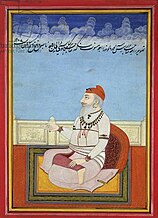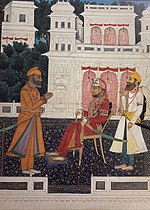| Nabha State | |||||||||||
|---|---|---|---|---|---|---|---|---|---|---|---|
| Princely State | |||||||||||
| 1763–1947 | |||||||||||
 Flag
Flag | |||||||||||
 Nabha State in a 1911 map of Ludhiana district | |||||||||||
| Area | |||||||||||
| • 1901 | 2,502 km (966 sq mi) | ||||||||||
| Population | |||||||||||
| • 1901 | 297,949 | ||||||||||
| Historical era | New Imperialism | ||||||||||
| • Established | 1763 | ||||||||||
| • Accession to the Dominion of India | 1947 | ||||||||||
| |||||||||||
| Today part of | India | ||||||||||

Nabha State, with its capital at Nabha, was one of the Phulkian princely states of Punjab during the British Raj in India. This state was ruled by Jats of Sidhu clan belonging to Sikh religion.
History
| This section needs expansion. You can help by adding to it. (February 2023) |
Origin

The ruling house of Nabha belonged to the Phulkian dynasty, sharing a common ancestor named Tiloka with the Jind rulers. Tiloka (r. 1652–1687) was the eldest son of Phul Sidhu of the Phulkian dynasty. The Nabha rulers descend from Gurditta (Gurdit Singh; r. 1687–1754), the elder son of Tiloka. Gurditta was the founder of the localities of Dhanaula and Sangrur. Sangrur was the headquarters of the state till it was captured by Jind State. Gurditta died in 1754. His only son Surat (or Suratya) Singh had died two years earlier in 1752, leaving his grandson, Hamir Singh, as the next in line. Hamir Singh was the founder of the locality of Nabha and the first ruler of Nabha State.
Foundation of the locality and state
The locality of Nabha was founded by Hamir Singh of the Phulkian dynasty in 1755, whilst the state itself was founded slightly after in 1763 by Hamir Singh. The state at that period of time was composed of twelve scattered territories. Hamir Singh died in 1783 and was succeeded by Jaswant Singh. However, a regency was in-place between 1783–1790. Jaswant Singh assumed full control on 1790 and ruled until 1840.
Alliance with the British
Between 1807–08, the ruler of Nabha was afforded British protection from the threat posed by Ranjit Singh and his encroaching Lahore State. Nabha State was loyal to the British during the Indian Mutiny of 1857, earning territory grants as a reward due to this. In 1911, Hira Singh took-on the maharaja title. Ripudaman Singh abdicated the throne of Nabha on 8 July 1923.
Dissolution
In the happenings of Indian independence in 1947, Nabha was one of the five Phulkian states that merged to become P.E.P.S.U., which itself was gradually merged into Punjab state.
State forces
The Nabha State Force consisted of a 500-strong infantry unit, including the Nabha Akal Infantry.
List of rulers
| No. | Name
(Birth–Death) |
Portrait | Reign | Enthronement | Ref. |
|---|---|---|---|---|---|
| Sardars | |||||
| 1 | Hamir Singh (died 1783) |

|
1763 – 1783 | ? | |
| Rajas | |||||
| 2 | Jaswant Singh (1775 – 22 May 1840) |

|
1783 – 1840 | ? | |
| 3 | Devinder Singh (5 September 1822 – 14/15 November 1865) |

|
1840 – 1846 | 15 October 1840 | |
| 4 | Bharpur Singh (5 October 1840 – 9 November 1863) |

|
1846 – November 1863 | ? | |
| 5 | Bhagwan Singh (30 November 1842 – 31 May 1871) |

|
1863 – 1871 | 17 February 1864 | |
| Maharajas | |||||
| 6 | Hira Singh (19 December 1843 – 24 December 1911) |

|
1871 – 1911 | 10 August 1871 | |
| 7 | Ripudaman Singh (4 March 1883 – 14 December 1942) |

|
1911 – 1923 | 24 January 1912 | |
| 8 | Pratap Singh (21 September 1919 – 22 July 1995) |

|
1923 – 1948 | ||
Demographics
| Religious group |
1881 | 1891 | 1901 | 1911 | 1921 | 1931 | 1941 | |||||||
|---|---|---|---|---|---|---|---|---|---|---|---|---|---|---|
| Pop. | % | Pop. | % | Pop. | % | Pop. | % | Pop. | % | Pop. | % | Pop. | % | |
| Hinduism |
133,571 | 51.02% | 164,905 | 58.32% | 160,553 | 53.89% | 126,414 | 50.79% | 133,870 | 50.84% | 132,354 | 46.02% | 146,518 | 43.09% |
| Sikhism |
77,682 | 29.67% | 63,047 | 22.3% | 78,361 | 26.3% | 76,198 | 30.62% | 78,389 | 29.77% | 97,452 | 33.89% | 122,451 | 36.01% |
| Islam |
50,178 | 19.16% | 54,397 | 19.24% | 58,550 | 19.65% | 46,032 | 18.5% | 50,756 | 19.27% | 57,393 | 19.96% | 70,373 | 20.7% |
| Jainism |
375 | 0.14% | 397 | 0.14% | 476 | 0.16% | 238 | 0.1% | 278 | 0.11% | 309 | 0.11% | 480 | 0.14% |
| Christianity |
18 | 0.01% | 10 | 0% | 7 | 0% | 5 | 0% | 41 | 0.02% | 66 | 0.02% | 221 | 0.06% |
| Zoroastrianism |
0 | 0% | 0 | 0% | 2 | 0% | 0 | 0% | 0 | 0% | 0 | 0% | 0 | 0% |
| Buddhism |
0 | 0% | 0 | 0% | 0 | 0% | 0 | 0% | 0 | 0% | 0 | 0% | 0 | 0% |
| Judaism |
— | — | 0 | 0% | 0 | 0% | 0 | 0% | 0 | 0% | 0 | 0% | 0 | 0% |
| Others | 0 | 0% | 0 | 0% | 0 | 0% | 0 | 0% | 0 | 0% | 0 | 0% | 1 | 0% |
| Total population | 261,824 | 100% | 282,756 | 100% | 297,949 | 100% | 248,887 | 100% | 263,334 | 100% | 287,574 | 100% | 340,044 | 100% |
| Note: British Punjab province era district borders are not an exact match in the present-day due to various bifurcations to district borders — which since created new districts — throughout the historic Punjab Province region during the post-independence era that have taken into account population increases. | ||||||||||||||
Gallery
-
 Photograph of Gurdwara Siropa Sahib in Nabha state, where historical Sikh relics and artefacts were kept for safe-keeping, published in Mahan Kosh (1930), c.1920s.
Photograph of Gurdwara Siropa Sahib in Nabha state, where historical Sikh relics and artefacts were kept for safe-keeping, published in Mahan Kosh (1930), c.1920s.
-
 Photograph of the Hira Mahal building in Nabha state, published in Mahan Kosh (1930), c.1920s.
Photograph of the Hira Mahal building in Nabha state, published in Mahan Kosh (1930), c.1920s.
See also
- Patiala and East Punjab States Union
- Political integration of India
- Phulkian sardars
- Phulkian Misl
- Patiala State
- Jind State
- Faridkot State
- Malaudh
- Bhadaur
- Kaithal
- Cis-Sutlej states
Notes
- Tiloka's personal name is alt. latinized as 'Tilokha'.
- 1931-1941: Including Ad-Dharmis
References
- Imperial Gazetteer of India, v. 18, p. 271.
- Chisholm, Hugh, ed. (1911). "Nabha" . Encyclopædia Britannica. Vol. 19 (11th ed.). Cambridge University Press. p. 147.
- Bates, Crispin (26 March 2013). Mutiny at the Margins: New Perspectives on the Indian Uprising of 1857: Volume I: Anticipations and Experiences in the Locality. SAGE Publishing India. ISBN 978-81-321-1589-2.
- ^ Truhart, Peter (2017). Regents of Nations: Asia, Australia-Oceania, Part 2 (Reprint ed.). Walter de Gruyter. p. 1398. ISBN 9783111616254.
- ^ Singh, Bhagat (1993). "Chapter 14 - The Phulkian Misl". A History of the Sikh Misals. Publication Bureau, Punjabi University.
- ^ "Nabha | Princely State, Maharaja, Punjab | Britannica". www.britannica.com. Retrieved 17 August 2024.
- "X. Nabha State Forces". Nabha Administration: A Review of Recent Years. Council of Regency of Nabha State. 1939. p. 29.
- "Census of India, 1881 Report on the Census of the Panjáb Taken on the 17th of February 1881, vol. I." 1881. JSTOR saoa.crl.25057656. Retrieved 26 December 2024.
- "Census of India, 1881 Report on the Census of the Panjáb Taken on the 17th of February 1881, vol. II". 1881. p. 14. JSTOR saoa.crl.25057657. Retrieved 26 December 2024.
- "Census of India, 1881 Report on the Census of the Panjáb Taken on the 17th of February 1881, vol. III". 1881. p. 14. JSTOR saoa.crl.25057658. Retrieved 26 December 2024.
- "The Punjab and its feudatories, part II--Imperial Tables and Supplementary Returns for the British Territory". 1891. p. 14. JSTOR saoa.crl.25318669. Retrieved 26 December 2024.
- "Census of India 1901. [Vol. 17A]. Imperial tables, I-VIII, X-XV, XVII and XVIII for the Punjab, with the native states under the political control of the Punjab Government, and for the North-west Frontier Province". 1901. p. 34. JSTOR saoa.crl.25363739. Retrieved 30 March 2024.
- "Census of India 1911. Vol. 14, Punjab. Pt. 2, Tables". 1911. p. 27. JSTOR saoa.crl.25393788. Retrieved 30 March 2024.
- Kaul, Harikishan (1911). "Census Of India 1911 Punjab Vol XIV Part II". p. 27. Retrieved 30 March 2024.
- "Census of India 1921. Vol. 15, Punjab and Delhi. Pt. 2, Tables". 1921. p. 29. JSTOR saoa.crl.25430165. Retrieved 30 March 2024.
- "Census of India 1931. Vol. 17, Punjab. Pt. 2, Tables". 1931. p. 277. JSTOR saoa.crl.25793242. Retrieved 30 March 2024.
- "Census of India, 1941. Vol. 6, Punjab". 1941. p. 42. JSTOR saoa.crl.28215541. Retrieved 30 March 2024.
External links
 Media related to Nabha State at Wikimedia Commons
Media related to Nabha State at Wikimedia Commons
| Gun salute princely states (salute states) during the British Raj in India | |
|---|---|
| 21-gun salute | |
| 19-gun salute | |
| 17-gun salute | |
| 15-gun salute | |
| 13-gun salute | |
| 11-gun salute | |
| 9-gun salute | |
| Princely states of the Punjab and Simla Hills in British India | |
|---|---|
| Punjab States Agency |
|
| Historical Punjab Hill States | |
| Simla Hill States Superintendency | |
30°22′N 76°09′E / 30.37°N 76.15°E / 30.37; 76.15
Categories: